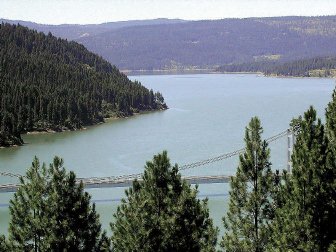forum
library
tutorial
contact

The Effect of Dams on Global Warming
by StaffEnvironmental News Network, August 20, 2012
|
the film forum library tutorial contact |

|
The Effect of Dams on Global Warmingby StaffEnvironmental News Network, August 20, 2012 |
 A new study has revealed the under-appreciation that exists for the role dams play in climate change; how the reservoirs behind them can cause surges of greenhouse gases as the water levels go up and down. In a study of the water column at such a reservoir, marine scientists found an astonishing 20-fold increase in methane emissions as water levels were drawn down. Bubbles coming out of the mud and sediment at the bottom were chock full of this potent greenhouse gas.
A new study has revealed the under-appreciation that exists for the role dams play in climate change; how the reservoirs behind them can cause surges of greenhouse gases as the water levels go up and down. In a study of the water column at such a reservoir, marine scientists found an astonishing 20-fold increase in methane emissions as water levels were drawn down. Bubbles coming out of the mud and sediment at the bottom were chock full of this potent greenhouse gas.
The role of lakes, reservoirs, and streams often go unnoticed when calculating carbon emissions. Most of the time we think about fossil fuel vehicles, factories, power plants, and landfills.
The truth is that there is a lot biological activity going on behind the dam. This is where the natural flow of sediment and living things stop and therefore accumulate. Through the decomposition of such creatures and organic material comes methane gas that builds up in the lake bed.
As levels of water go down, the lake bed heats up because more sunlight is hitting it. The rising temperatures cause the methane to bubble up and out into the atmosphere. This is particularly true in summer because low oxygen conditions at the depth of the reservoir creates an ideal condition for microbial activity that creates the methane.
The recent study was conducted at Lacamas Lake in Clark County, Washington, by Washington State University researchers Bridget Deemer and Maria Glavin. They wanted to challenge the notion that lakes and reservoirs acted as carbon sinks, where carbon dioxide is absorbed from the atmosphere. They concluded that their carbon storage abilities could be less than one fourth what was estimated, when accounting for the drawdown of water in reservoirs. In the United States, reservoirs behind dams take up a tiny fraction of overall land surface. However, due to their increased biological activity, they have an outsized effect on methane emissions. Across the country there are about 80,000 dams.
According to the student's advisor, John Harrison, assistant professor of Earth and Environmental Sciences, this research could lead to new methods of managing reservoirs by timing the water drawdowns to avoid the summer months. "We have the ability to manage the timing, magnitude and speed of reservoir drawdowns, which all could play a role in how much methane gets released to the atmosphere," Harrison says.
Their research continues to find out the optimal way to drawdown water from a reservoir, the optimal time for dam removal, and whether or not the placing of certain plants and soils might help.
The current study is being presented at the national meeting of the Ecological Society of America in Portland, Oregon.
learn more on topics covered in the film
see the video
read the script
learn the songs
discussion forum
